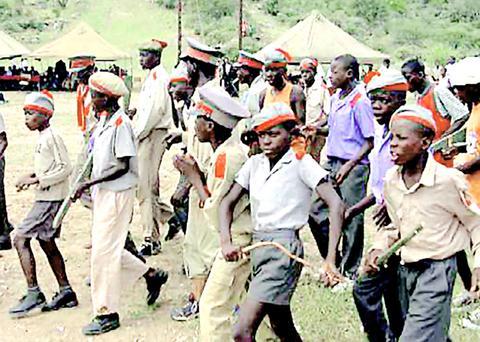Some brandishing sticks to represent rifles, others on horseback, hundreds of members of Namibia's Herero tribe on Friday re-enacted a bloody battle to commemorate an uprising against colonial German forces a century ago.
But the underlying theme of celebrations near the small Namibian town of Ovitoto, about 100km northeast of Windhoek, was one of reconciliation between the Namibian tribe and its former colonial ruler.

PHOTO: AFP
Dressed in black Victorian garments and wearing their distinct and colorful head-dresses, Herero women ululated, giving a chilling performance of the battle cries that spurned on their men during the re-enactment of the Battle of Okandjira which happened on April 9, 1904.
About 25 "German" soldiers dressed in blue uniforms represented some 800 colonial "Schutztruppe" (protection troops) who squared up against 10,000 Herero warriors during an uprising in the former German colony.
Opposing the riders were some 50 Herero horsemen who advanced while the troops lay in ambush in nearby scrubland.
Some 80 Herero fighters and 25 Germans under the command of major Theodor Leutwein, then governor of former German South West Africa, died in the clash.
With the thundering "Hu, hu!" the traditional Herero battle cry, the riders chased past as a nearby sound system rendered battle sounds and rifles bursts.
The "wounded" Germans were then taken from the battle scene to a clearing at the foot of the Okandjira Mountain.
The Battle of Okandjira lasted from dusk to dawn, ending in retreat for Herero fighters, women and children.
The Herero uprising eventually led to an "extermination order," issued by German colonial officers later in 1904 which resulted in the killing of thousands of the tribe's members.
A year later, in 1905, when the operation ground to a halt, about 16,000 of an estimated 60,000 to 80,000 Herero were left -- 14,000 of them in concentration camps.
Today, Hereros represent about seven percent of Namibia's 1.8 million-strong population, having never fully recovered from the executions at the turn of the century.
But speeches centered not around war on Friday, but around the reconciliation of two peoples.
"We would like the Germans to build us a monument at this spot to honor our ancestors," said Mostert Tjihuiko, the chairman of the Ovaherero 1904 Genocide Committee. "We can forgive, but we will never forget."
German ambassador to Namibia Wolfgang Massing spoke of a "new chapter in our common history" between Germany and the Herero people after the "difficult past for both sides."
He said: "Germany is prepared to help you to remember your history and [help you] if you want to erect a monument."
Afterwards Massing and Herero Chief Riruako laid wreaths at the graves of Herero warriors and colonial German officers.
"This we do together in the spirit of reconciliation exactly one hundred years after the fierce battle," said Chief Riruako while clasping the hand of the German ambassador.
A member of the Herero tribe in neighboring Botswana Stephen Kazeire Raurau told reporters he believed Herero members should be taught about their history.
"Today I stand here on the soil where my ancestors lost their blood and their lives a century ago. Our Herero people in South Africa must be taught about their culture."

Former Nicaraguan president Violeta Chamorro, who brought peace to Nicaragua after years of war and was the first woman elected president in the Americas, died on Saturday at the age of 95, her family said. Chamorro, who ruled the poor Central American country from 1990 to 1997, “died in peace, surrounded by the affection and love of her children,” said a statement issued by her four children. As president, Chamorro ended a civil war that had raged for much of the 1980s as US-backed rebels known as the “Contras” fought the leftist Sandinista government. That conflict made Nicaragua one of

COMPETITION: The US and Russia make up about 90 percent of the world stockpile and are adding new versions, while China’s nuclear force is steadily rising, SIPRI said Most of the world’s nuclear-armed states continued to modernize their arsenals last year, setting the stage for a new nuclear arms race, the Stockholm International Peace Research Institute (SIPRI) said yesterday. Nuclear powers including the US and Russia — which account for about 90 percent of the world’s stockpile — had spent time last year “upgrading existing weapons and adding newer versions,” researchers said. Since the end of the Cold War, old warheads have generally been dismantled quicker than new ones have been deployed, resulting in a decrease in the overall number of warheads. However, SIPRI said that the trend was likely

NUCLEAR WARNING: Elites are carelessly fomenting fear and tensions between nuclear powers, perhaps because they have access to shelters, Tulsi Gabbard said After a trip to Hiroshima, US Director of National Intelligence Tulsi Gabbard on Tuesday warned that “warmongers” were pushing the world to the brink of nuclear war. Gabbard did not specify her concerns. Gabbard posted on social media a video of grisly footage from the world’s first nuclear attack and of her staring reflectively at the Hiroshima Peace Memorial. On Aug. 6, 1945, the US obliterated Hiroshima, killing 140,000 people in the explosion and by the end of the year from the uranium bomb’s effects. Three days later, a US plane dropped a plutonium bomb on Nagasaki, leaving abut 74,000 people dead by the

Indian Prime Minister Narendra Modi is to visit Canada next week, his first since relations plummeted after the assassination of a Canadian Sikh separatist in Vancouver, triggering diplomatic expulsions and hitting trade. Analysts hope it is a step toward repairing ties that soured in 2023, after then-Canadian prime minister Justin Trudeau pointed the finger at New Delhi’s involvement in murdering Hardeep Singh Nijjar, claims India furiously denied. An invitation extended by new Canadian Prime Minister Mark Carney to Modi to attend the G7 leaders summit in Canada offers a chance to “reset” relations, former Indian diplomat Harsh Vardhan Shringla said. “This is a